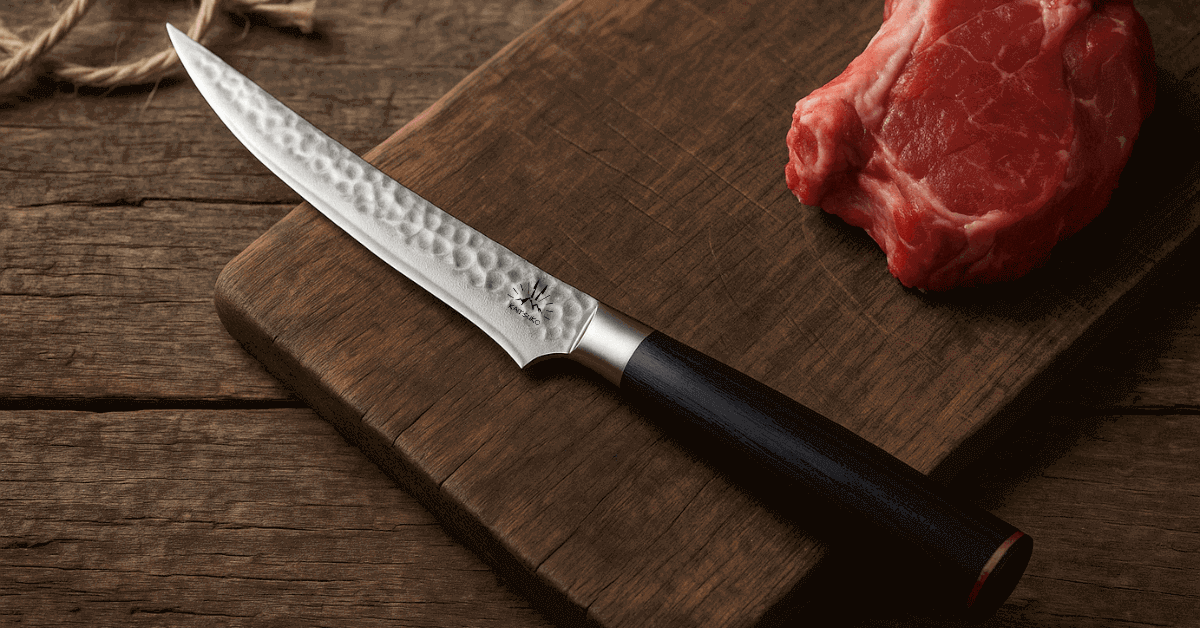The best skinning knife is the one that lets you work quickly, cleanly, and without wasting meat. It’s that simple. Whether you’re a seasoned hunter or a meticulous butcher, choosing the right blade is no place for guesswork. Sharpness, handling, steel, and blade shape — every detail matters.
But be warned: not all knives are made to follow muscle lines or glide effortlessly between tendons. If you want to save both your meat and your nerves, this guide will help you choose the best skinning knife for your specific needs. Let’s get into it.
What Is the Best Skinning Knife?
The best skinning knife is the one that naturally follows muscle fibers with the grace of a finely honed blade. Used to remove skin, separate meat, and debone cleanly, this tool is all about precision — a must-have for hunters, butchers, and wild game processors alike.
A Must-Have for Hunters and Butchers
Whether you're field dressing a freshly taken wild boar or prepping a carcass in an artisan butcher shop, you need a tool that’s precise, razor-sharp, and perfectly adapted to animal anatomy.
That’s exactly why a high-quality skinning knife is engineered to follow natural contours while minimizing meat loss. All the more reason to invest in a premium Japanese knife built to last for years.
Skinning Knife vs. Hunting Knife: What’s the Difference?
A common confusion — but a critical one:
-
A hunting knife is versatile, designed for all-around fieldwork (branch cutting, field dressing, etc.).
-
A skinning knife is a specialist: built for one task only — cleanly separating skin from flesh.
Key Features of a Great Skinning Knife
Choosing a great skinning knife means understanding the logic of the cut. The blade must hug contours, slip between tissues, and allow for confident, controlled movements.
Blade Shape and Curvature
Curvature is king. A proper skinning knife has a slim, curved blade, ideal for tracing muscle lines, sliding along bones, and separating tissues cleanly. The shape ensures precise control while protecting the meat’s integrity.
The more pronounced the curve, the better the flow and precision — especially around joints or the ribcage.
Ideal Blade Length for Efficient Skinning
The sweet spot? Between 10 and 15 cm.
-
Under 10 cm: too short, limits efficiency
-
Over 15 cm: too bulky, hard to handle in tight spaces
Steel Quality and Edge Retention
The core of every knife is its steel. A dependable edge is essential, especially during long processing sessions.
Common choices:
-
Stainless steel: corrosion-resistant, great in wet/muddy conditions
-
Carbon steel: holds a razor edge longer, but needs extra care
-
Damascus steel: combines strength, beauty, and long-term durability
Grip Comfort and Handling
A skinning knife should feel like an extension of your hand. Field conditions aren’t always perfect — wet hands, gloves, cold weather...
Look for:
-
Ergonomic handle that fits naturally in your palm
-
Non-slip grip, stable even with blood or moisture
-
Balanced weight to reduce fatigue over time
A slippery or unbalanced knife kills precision — and could cause injury.
At Kaitsuko, our mission is first and foremost to help you find the best kitchen knife through our range of high-quality Japanese knives!
What Kind of Knife Is Best for Skinning?
There’s no perfect skinning without the right blade type. Your choice depends entirely on how you’ll use it in the field.
Fixed Blade vs. Folding Knife
-
Fixed blade: the pro’s choice. More robust, no moving parts, always ready to cut. Withstands force, deep cuts, and heavy use without compromise.
-
Folding knife: compact and discreet. Ideal for portability but usually less rigid, less safe, and not as durable.
Blade Shapes Compared: Drop Point, Skinning, Trailing Point
-
Drop Point: gently sloping spine to tip. All-purpose favorite — solid, reliable, good control. A great choice for mixed tasks.
-
Skinning Blade: curved, rounded tip. Built specifically for skinning without piercing the flesh. The purest option.
-
Trailing Point: high-curved tip for long, sweeping cuts. Glides beautifully but can be fragile and less stable.
For pure skinning: go Skinning.
For versatility: Drop Point is best.
Best Skinning Knives on the Market
For Large Game (Deer, Boar, Elk…)
Go big: longer blade (up to 15 cm), anti-slip handle, max durability.
Top brands: Benchmade, ESEE, Outdoor Edge
For Small Game & Poultry
Precision matters here. For pheasants, rabbits, or hare, opt for a shorter, more flexible blade (10–12 cm).
Great picks: Buck PakLite, Morakniv, Opinel Game Series
Why? Razor-sharp edge and excellent control without damaging the meat.
How to Care for a Skinning Knife
Many forget this, but a skinning knife must be properly maintained.
Why? Because blood, moisture, fat, and organic residue will dull the blade and shorten its life.
Cleaning After Game Processing
Clean after every use.
-
Wash with warm soapy water – never in a dishwasher
-
Disinfect with alcohol or a game-safe spray, especially for meat to be eaten
-
Dry thoroughly and lightly oil the blade (especially carbon steel)
Sharpening and Honing
Even premium steel dulls over time. To keep your edge razor-sharp:
-
Use a medium/fine whetstone for regular sharpening
-
A ceramic honing rod for quick touch-ups
-
Adjust frequency based on use: after every heavy session or every 2–3 uses for light fieldwork
Explore our sharpening tools and accessories
Conclusion
The best skinning knife is the one that fits your hand, your game, and your workflow.
Curved blade, quality steel, non-slip handle, proper length — every detail counts.
Want to go further? Read our guide on choosing between a hunting dagger and a skinning knife!







Best Kitchen Knife Blocks: Comparison and Buying Tips
Best Boning Knives: Our Selection and Buying Guide